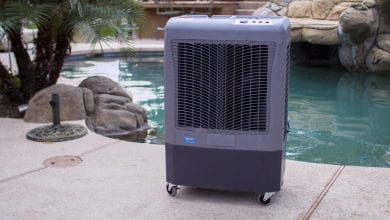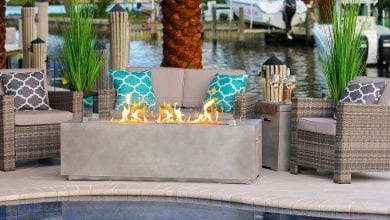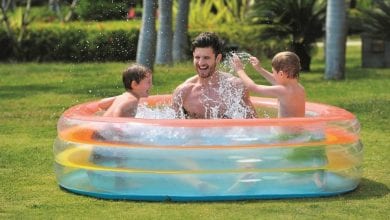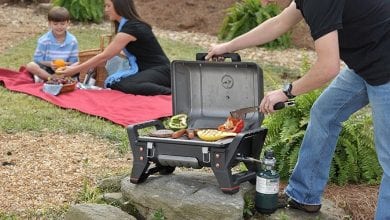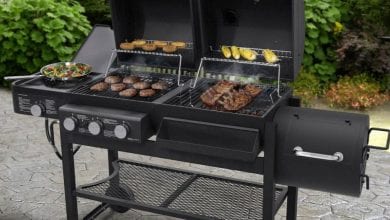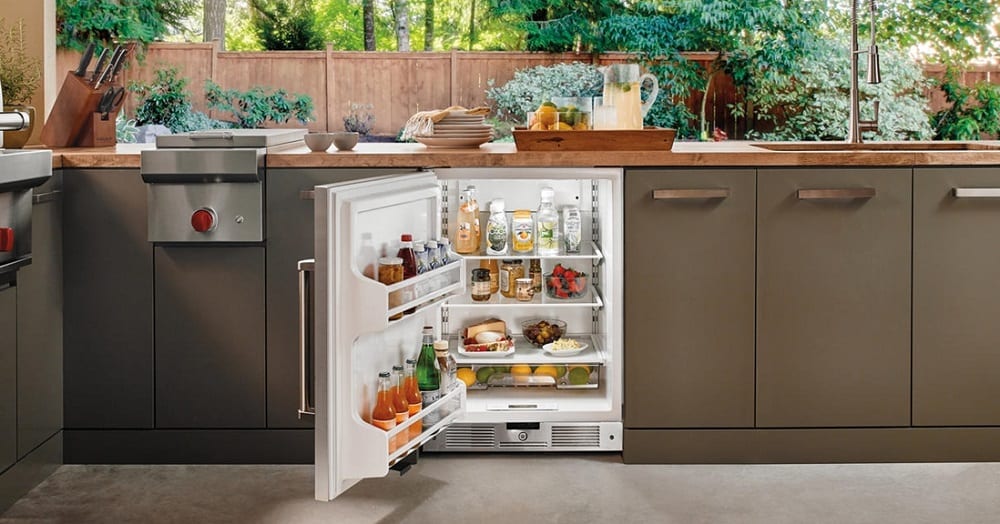
Best Outdoor Refrigerators in 2022 – Reviewed
Spending time outdoors socializing with friends and family or cooking can be a whole lot of fun, but it can also be inconvenient when you have to run back into the house to get drinks and/or food to cook. That’s why the outdoor areas of most people would be vastly improved with the addition of a refrigerator. Buying the best outdoor refrigerator allows the homeowner to spend more time outside tending to their grill or hanging out with friends, and that’s why we’ve decided to review some of the top models being manufactured nowadays. Let’s take a look at each of these refrigerators and see which one might suit your needs.
Quick Summary of Best Outdoor Refrigerators



Reviews
Editor’s Choice: Bull Outdoor Products Stainless Steel Refrigerator
 Bulldog Outdoor Products makes this high-quality refrigerator so that people can use it to store drinks and or food in their outdoor spaces. This model features 4.4 cubic feet of space that are plenty big enough to suit the needs of most people. Inside of this refrigerator, there are three levels of shelving that allow people to sort their food and drinks and a bottom drawer that can be used to hold snacks or pieces of fruit. It also has shelves inside the door where cans of soda can be dispensed or where bottles of soda can be stored. This keeps everything nice and handy and within the consumer’s reach.
Bulldog Outdoor Products makes this high-quality refrigerator so that people can use it to store drinks and or food in their outdoor spaces. This model features 4.4 cubic feet of space that are plenty big enough to suit the needs of most people. Inside of this refrigerator, there are three levels of shelving that allow people to sort their food and drinks and a bottom drawer that can be used to hold snacks or pieces of fruit. It also has shelves inside the door where cans of soda can be dispensed or where bottles of soda can be stored. This keeps everything nice and handy and within the consumer’s reach.
Now that we’ve looked at the inside of this refrigerator, let’s take a few moments and look at the outside of it. This model has a 304 stainless steel door and a stainless steel exterior door panel that’s resistant to fingerprints. Another thing that we liked about this refrigerator was that it had a reversible door that can be set to either swing out from the left side or from the right side. This feature gives consumers a lot of different options when they’re installing it into an outdoor refrigerator enclosure. And because this refrigerator has a flush back design, it’s extremely easy to setup.
This refrigerator is approximately 20.5x33x20.75-inches and weighs approximately 51.2 pounds. We would also like to mention that this refrigerator also has a full-range temperature control that allows the consumer to set it exactly in the way they need to set it.
And the final thing we’d like to say about this product is that it’s designed for actual outdoor use—unlike some of the other patio refrigerators being sold nowadays. It’s ETL-listed and as long as it’s properly protected from being directly in the elements, the consumer should have no problem with it. If the consumer properly installs it into their outdoor patio area, they should be able to get plenty of use out of it.
- This refrigerator works well.
- It’s extremely durable.
- It’s reasonably priced.
- None.
Also Recommended: Danby Outdoor-Rated 4.4 Cubic-Foot Fridge
 Anyone looking for an outdoor fridge that will do a great job of keeping food and beverages cold and be able to easily hold up to outdoor conditions is going to want to take a look at this model. This is a fridge that has an IPX4 water-resistance rating and has castors equipped with stainless-steel ball bearings that provide additional resistance to rust. The manufacturer of this fridge has also made the unprecedented decision to cover the electrical housing is waterproof and UV resistant plastics for added durability. And there is probably no other fridge that’s been rated for a tropical environment than this one. It has been shown to maintain its cooling capacity, even in temperatures in excess of 109-degrees Fahrenheit.
Anyone looking for an outdoor fridge that will do a great job of keeping food and beverages cold and be able to easily hold up to outdoor conditions is going to want to take a look at this model. This is a fridge that has an IPX4 water-resistance rating and has castors equipped with stainless-steel ball bearings that provide additional resistance to rust. The manufacturer of this fridge has also made the unprecedented decision to cover the electrical housing is waterproof and UV resistant plastics for added durability. And there is probably no other fridge that’s been rated for a tropical environment than this one. It has been shown to maintain its cooling capacity, even in temperatures in excess of 109-degrees Fahrenheit.
Now that all of us understand how well this outdoor refrigerator is designed, it’s time to talk about some of its other features. What we especially liked about this refrigerator was that it provided 4.4 cubic feet of storage space. It features two glass shelves and another half shelf that’s good for holding snacks or beverages.
This fridge also has a stylish flat top that gives people a place to place a drink tray or maybe a pack of paper plates and napkins for outdoor entertaining. This product is approximately 21.3×20.75×33-inches in size, weighs about 68 pounds, and has a rubberized handle that makes it easy to open. And because the outside stainless-steel of this fridge is fingerprint resistant, people can feel free to use it around young children or anyone else with messy fingers.
Taking all of this into consideration, it’s easy to see why so many people choose this great outdoor refrigerator. It’s extremely well made, it’s designed to be weather-resistant, and it keeps food/beverages nice and cold. All good reasons why a consumer looking for a new fridge for their outdoor spaces might take a few moments and look at this one.
- It has an IPX4 water-resistance rating.
- It provides 4.4 cubic feet of indoor space.
- It costs more than some other outdoor fridges.
Also Consider: RCA 3.2 Cubic-Foot Mini-Frdige With Freezer
 Before we begin the review from this RCA fridge, we should state that this unit isn’t specifically designed for outdoor use. What we mean by that is that it shouldn’t be used in the same way that outdoor fridges are used because that could ruin this warranty. However, what we would say that this refrigerator is good for is to be used on a covered outdoor area such as a porch or someplace else where it won’t be subject to the elements. With that being said, we still think that it’s a great refrigerator, especially considering its low price, it just isn’t suitable for being used as a truly outdoor fridge.
Before we begin the review from this RCA fridge, we should state that this unit isn’t specifically designed for outdoor use. What we mean by that is that it shouldn’t be used in the same way that outdoor fridges are used because that could ruin this warranty. However, what we would say that this refrigerator is good for is to be used on a covered outdoor area such as a porch or someplace else where it won’t be subject to the elements. With that being said, we still think that it’s a great refrigerator, especially considering its low price, it just isn’t suitable for being used as a truly outdoor fridge.
This fridge is approximately 17.5×18-5/8×31-5/8 inches in size, weighs a little bit over 50 pounds, and has an inner fridge space of 3.2 cubic feet. It also has a freezer with a capacity of 0.2 cubic feet for storing a small number of frozen food items. This fridge/freezer uses R134a refrigerant and it’s compressor provides high cooling performance even in hot weather conditions. It also features an adjustable thermostat that allows the consumer to have full control over its cooling capacity and set it according to their needs. Another thing that we found useful about this product was that it had a reversible door that could be set to open outwards from either the right or the left.
It’s also worth mentioning that this product is an Energy-Star rated appliance, so the consumer can rest assured that it’s not going to drive up their energy bill needlessly. Other features that we’d like to discuss about this fridge include a low profile that allow it to have a flush look to it when it’s installed, adjustable lever feet, and sleek stainless steel look to it. It also has a pretty reasonable price tag, so the consumer won’t feel like they broke the bank when purchasing one of these amazing fridges.
- This is an inexpensive outdoor refrigerator.
- This fridge does an amazing job of staying cold.
- Not entirely weather resistant.
A Guide To Outdoor Refrigerators
There are so many different types of outdoor refrigerators on the market these days, it almost boggles the mind. There are luxury models, premium models, and even some models that have no place being used in outdoor spaces, so it’s important for the consumer to think carefully about any outdoor refrigerator they’re thinking about buying. To speed up the buying process and help our readers sort the quality models from the not-so-good models, we’ve decided to write this guide on the subject. So let’s get to it, shall we?
Think About The Type Of Outdoor Refrigerator Needed
The first thing that anyone is going to want to think about before purchasing a new outdoor refrigerator is which one they might need. As we stated in our intro, these refrigerators come in one of three different styles: Luxury, Premium, and Standard refrigerators. Let’s take a look at them and see what niche each of them fills.
Standard Refrigerators
These are refrigerators that are smaller than your household fridge but look like mini versions of your home fridge. However, they usually work using a cold-plate refrigeration system instead of forced-air refrigeration. These models are inexpensive, but they’re not usually very durable and many of them aren’t even rated for outdoor use. This makes these models unsafe to use outdoors unless they are being used in a location such as a covered porch where they won’t get exposed to the elements.
Premium Refrigerators
These refrigerators are rated for outdoor use and are usually equipped with durable compressors that hold up quite well in hot conditions. These refrigerators also usually have stainless steel exteriors and doors that make them more durable than standard refrigerators. These refrigerators are usually easy to install in cabinetry and they can come with various features such as colored lights or glass doors.
Luxury Refrigerators
These refrigerators are also rated for outdoor use and usually contain high-power compressors that can keep food cold in warm conditions but doesn’t make a lot of noise in the process. These refrigerators usually come with extended warranties that give the consumer peace of mind and have some of the lowest temperature settings, too. Some of the additional features that can be found on some of these models include temperature alarms, locking doors, and digital controls.
Do You Need An Equipped Freezer?
Another thing that a person should think about when choosing a new fridge for their outdoor spaces is whether they need it to have a freezer or not. Not all outdoor refrigerators have freezers, so it’s something to carefully consider before settling on a model.
Reversible Doors
Reversible doors are another feature that some consumers might want to consider. This feature allows the door to be installed from one side or the other so that it can be opened outward from the left or the right. This feature gives the consumer plenty of options when installing the fridge into a cabinet so that they don’t have to build a new enclosure just because the fridge opens up in the wrong way than what they need.
Other Features To Consider
As we come to the conclusion of this guide, we would like to talk about some of the other features that consumers might want to consider when purchasing a new outdoor refrigerator. Although the following features won’t be found on every model, and many of them aren’t strictly necessary for a refrigerator to be considered a quality outdoor unit, they are worth thinking about.
- Fingerprint resistant exteriors
- LED lighting
- Removable feet
- Adjustable controls
Outdoor Refrigerator Safety Tips
Now that we concluded the buying tips section of this guide, we want to conclude it with some tips on using outdoor refrigerators. The following tips will help our readers use their fridges in a more sensible and responsible manner that not only protects them from potential hazards but also keeps the appliance safe as well.
An Outdoor Refrigerator Isn’t Designed For Extreme Conditions
One of the first things that consumers should think about is how they use their refrigerator outdoors. These fridges aren’t designed to withstand direct exposure to weather or exposure to extreme weather conditions. The fridge should be encased in a proper enclosure, shouldn’t be left exposed to extreme rains or snow, and shouldn’t be left outside all winter long. If the consumer is going to use the fridge in extremely hot conditions, they might also want to make sure the unit is properly insulated from direct sunlight and heat to keep the compressor from working too hard.
Use The Fridge As It Was Designed To Be Used
Another thing to think about is whether the refrigerator is designed to be a freestanding unit or is intended to be built into a cabinet or some other piece of furniture. Freestanding units need space for ventilation around their top, back, and sides. Built-in models are designed to be in an enclosure, so their vents are located at the front and bottom of the unit. Regardless of which fridge is used, the most important thing to remember is to never block the unit’s vents and to allow air to circulate as the manufacturer states in their instructions.

